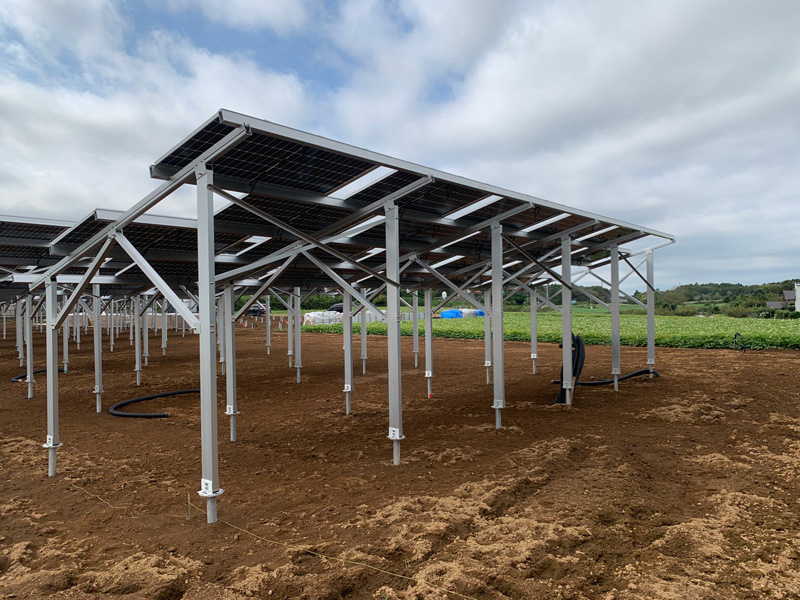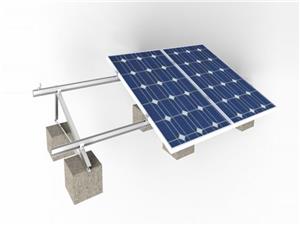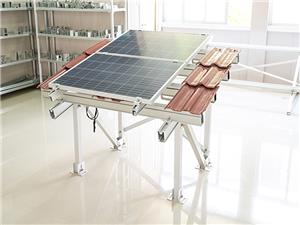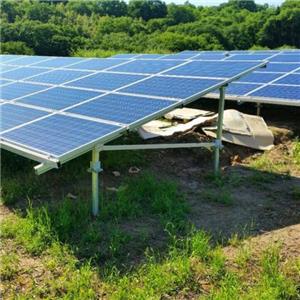Design and selection of solar photovoltaic module mounting structure
Design and selection of solar photovoltaic module mounting structure
In view of the direct relationship between solar photovoltaic module power generation and sunlight intensity, time, as well as the placement and inclination of the solar panels, in view of the current situation that most of the brackets cannot be adjusted at the angle and the power generation efficiency is relatively low, a design can be designed according to different latitudes.
PV system bracket for adjusting the angle of the area. In this paper, the connection method, material, type selection, and load analysis of the photovoltaic module bracket system are analyzed and explained in detail. At the same time, the photovoltaic module can not only adjust the horizontal angle according to the needs, but also has high strength, which can be used in high wind speed and snowy areas. Use, have a certain promotion significance and application prospect。starwin is a solar racking manufacturers in china.

1 Introduction
At present, in the context of global energy supply shortages and increasingly serious environmental problems, the sustainable development of the economy and society has been greatly challenged, and the development and use of clean and safe renewable energy has received extensive attention. Although there are many types of renewable alternative energy sources that have been utilized, hydropower, wind power, and tidal energy are all too small to meet human needs in terms of total available energy. As a kind of renewable energy that is rich in resources, widely distributed and can be used permanently, solar energy has great potential for development and utilization. Especially in the 21st century, the solar photovoltaic power generation industry is developing very rapidly. Solar photovoltaic power generation will not only replace some conventional energy sources in the near future, but will also become the main body of the world's energy supply and will bring revolutionary changes to energy development. According to the forecast of the European Joint Commission Research Center (JRC), by the end of the 21st century, renewable energy will account for more than 80% of the energy structure, of which solar power will account for more than 60%, fully demonstrating its important strategic position.
The solar photovoltaic module mounting structure is an important component for fixing solar panels. Under the premise of obtaining the maximum power generation efficiency of solar panels, ensuring the safety and reliability of the bracket is a matter of consideration and research for photovoltaic module manufacturers. According to the needs of different forms of solar photovoltaic power generation, bracket systems are generally divided into single-pillar solar brackets, double-pillar solar brackets, matrix solar brackets, roof solar brackets, wall solar brackets, tracking system series brackets and other specifications and models. The installation methods are divided into ground installation system, roof installation system and building energy-saving integrated bracket installation system.
2. Photovoltaic module bracket design
2.1 Photovoltaic module support structure
At present, most of the commercial solar photovoltaic module mounting brackets cannot adjust the angle. The use of tracking methods for solar power generation wastes a lot of manpower and material resources, and the input-output ratio is limited to a certain extent. This paper designs a photovoltaic system bracket that can adjust the angle according to different latitudes. (as shown in Figure 1) the bracket system can adjust the horizontal angle according to the needs. It is not only suitable for the use of ground photovoltaic power stations, but also can be used on the roof Used in power stations, the installation angle of the bracket can be quickly adjusted during the installation process, avoiding the disadvantage that the conventional photovoltaic module bracket cannot quickly adjust the installation angle. At the same time, the module bracket adopts a high-carbon steel structure and the surface is hot-dip galvanized material, which has low cost , High strength, strong corrosion resistance of selected materials, and can be used in areas with relatively harsh environments. This system includes a triangular main bracket 1; a supporting connecting mechanism 2; a scale positioning plate 3; a positioning hole 4; a plunger type scale pin 5; a supporting plate 6; a pressing plate 7; a bearing sleeve 8; a connecting rod 9; The main frame of the system is a triangular welded structure, which is simple in structure and can bear enough load. The battery assembly is fixed to the supporting connection mechanism by bolts, and the angle is adjusted by a dial. The scale positioning plate is fixed by the plunger-type scale pin. The supporting plate, pressure plate and bearing sleeve are used with the scale positioning plate. The connecting rod and the foot support are used to increase the strength of the photovoltaic module bracket.
2.2. Photovoltaic module bracket connection method
When installing the photovoltaic module mounting system, the base is fixed by embedded bolts, as shown in Figure 2. The foot support at the bottom of the bracket is put into the base and connected with the base by bolts, and then the battery modules are installed. The photovoltaic modules are connected with the support mechanism 2 by bolts. The required angle is adjusted by the scale positioning plate 3 and the positioning pin 5, and the installation is completed. One group. When the matrix solar power is connected, the two sets of adjacent module brackets are fixed by the fastening sheet 11 to enhance its strength
2.3 Material selection of photovoltaic module bracket
At present, the solar photovoltaic stent systems commonly used in my country are divided into three types: concrete stents, steel stents and aluminum alloy stents. Concrete supports are mainly used in large-scale photovoltaic power stations. Because of their self-weight, they can only be placed in the field and in areas with good foundations. However, they have high stability and can support large-scale solar panels. Aluminum alloy brackets are generally used in solar energy applications on the roof of civil buildings. Aluminum alloy has the characteristics of corrosion resistance, light weight, beautiful appearance and durability, but its low bearing capacity cannot be applied to solar power station projects.
The steel bracket designed in this paper has stable performance, mature manufacturing technology, high load-bearing capacity, easy installation, excellent anti-corrosion performance, beautiful appearance and unique connection design, convenient and quick installation, simple and universal installation tools, using structural anti-corrosion materials steel and stainless steel zero Components, the service life is more than 20 years.
2.4 Analysis of photovoltaic module support load
The strength of the bracket mainly includes the calculation of the fixed load (the weight of the component and others), the wind load and the snow load. The wind load refers to the wind pressure blowing from the front of the bracket (downwind) and the wind pressure blowing from the back of the bracket (upwind). The bending strength and amount of bending of the material, the buckling (compression) and tensile strength of the support arm and the structural changes caused by normal ground and roof vibration and settlement.
2.4.1 Force analysis of snow load
The snow load is shown in formula 2-1:
S=Cs*P*Zs*As(2-1)
Where S is the snow load, Cs is the slope coefficient, and P is the average unit mass of snow (equivalent to the mass of 1cm of snow and the mass of 1m2 in area). Generally, the area is 19.6N or more, and the snowy area is 29.4N or more. Zs is the deepest vertical snow cover (cm) on the ground, and As is the snow area. The design snow volume of the solar cell array is set to the deepest vertical snow volume (Zs) on the ground. However, if the snow volume is reduced due to frequent snow sweeping, the Zs value can be reduced according to the situation.
2.4.2 Force analysis of wind speed load
The photovoltaic module bracket designed in this paper is checked whether the strength and deflection meet the requirements under the wind speed of tenth wind (27m/s).
2.4.2.1 Normal stress check
When the photovoltaic module support beam is bent in one direction, the normal stress is as shown in formula 2-2:
(2-2)
Where Mx is the bending moment of the same section beam in the plane of maximum stiffness (x-axis); Wnx is the net section modulus (flexural section modulus) to the x-axis; it is the design value of steel strength. According to formula 2-2, the normal stress is as shown in formula 2-3:
After checking the hardware manual, the design value is [f], σmax<[f], so it meets the strength requirements.
2.4.2.2 Check the deflection
The maximum deflection of the beam span is shown in formula 2-4:
Where l0 is the calculated span of the beam; S is the simply supported beam that is related to the load form and supporting conditions and acts on uniformly distributed loads. S=5/384; E is the elastic modulus; M is the maximum bending moment in the middle of the span; EI is The bending stiffness of the section. The longitudinal calculation is the same as above.
2.4.2.3 Tensile and compressive strength of the rear support arm
2.4.2.3.1 Headwind
The wind pressure load W acts as a tensile load on the support arm and becomes an upward blowing load (lifting force). The tensile stress is shown in formula 2-5:
In the formula, P is the tensile tension; A is the cross-sectional area of the support arm. Check the design value of the tensile strength of Q235 steel [f], <[f], so there is no problem.
2.4.2.3.2 Downwind occasions
When the component bracket is compressed with a longer length than the cross-sectional width, the probability of bending failure is higher than compression failure. This is called buckling of the column, and the load at this time is called buckling load. The buckling load (Eulerian formula) is shown in formula 2-6:
Where is the buckling load; is the moment of inertia of the axial section; is the coefficient determined by the support conditions at both ends, and is 1 when the hinges at both ends are hinged; is the longitudinal elastic coefficient of the material; L is the axial length. The calculation process of the tensile and compressive strength of the front support is the same as that of the rear support.
3. Application prospects
The current international energy situation is relatively severe, and countries are striving to find new energy sources that can replace conventional fossil energy. In addition, the safety of nuclear power generation is questionable. Wind and hydropower are greatly affected by regions and seasons. However, solar energy is an inexhaustible and inexhaustible clean energy source that attracts attention and uses. With the widespread promotion and application of large-scale ground and rooftop solar photovoltaic systems around the world, solar photovoltaic power generation has become one of the indispensable sources of power generation in power supply. At the same time, in order to ensure the reliable, safe and stable operation of photovoltaic module systems, it must be required The various components of the solar module have good wind resistance, snow pressure resistance, and corrosion resistance. The solar photovoltaic module bracket installation designed in this paper not only meets the performance of wind resistance, snow pressure resistance, and corrosion resistance, but also can be fully suitable for ground matrix solar energy and rooftop solar energy systems. The solar photovoltaic module bracket has a good application prospect in future photovoltaic power generation applications.
Based on the shortcomings of conventional solar photovoltaic module brackets and combined with the characteristics of solar power generation, this paper designs a new type of solar photovoltaic module bracket. The unique design structure of the photovoltaic module allows the module to be adjustable in angle according to different regions, so as to make full use of the local solar energy resources and achieve the maximum power generation efficiency of the solar module. At the same time, the detailed analysis and practice of the photovoltaic module connection method, material selection and support load force analysis make it have good physical properties such as earthquake resistance, wind resistance, snow pressure resistance, and corrosion resistance, so that photovoltaic modules can be used in A wider geographical area.




